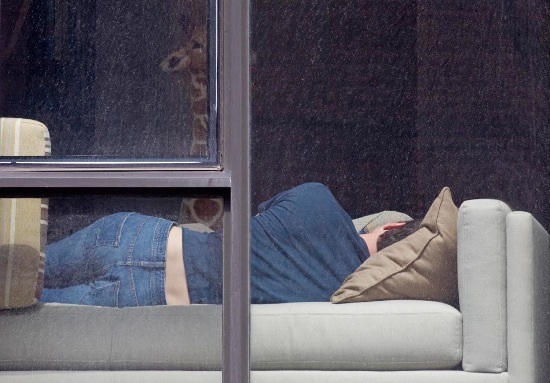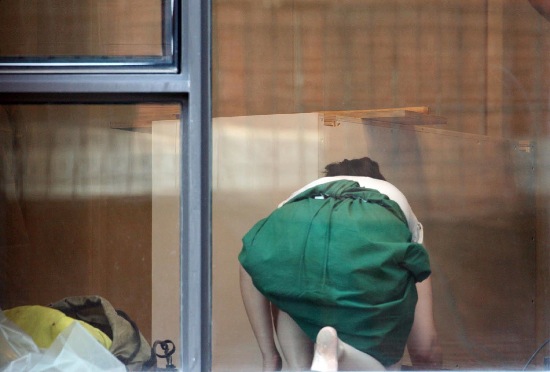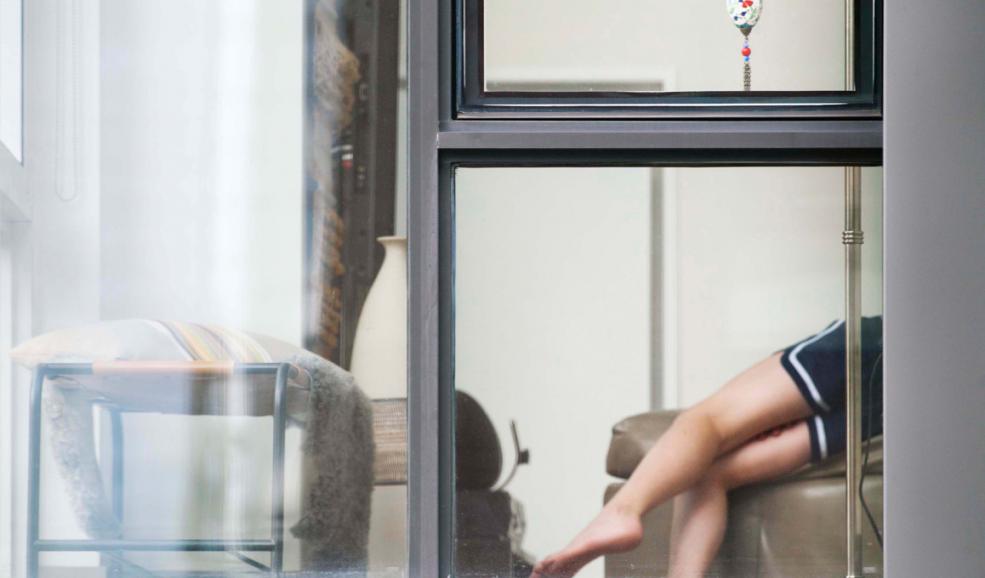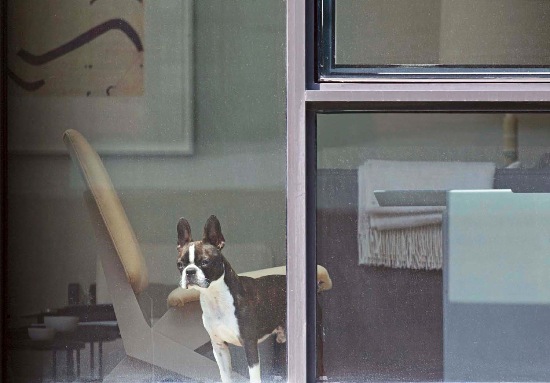Andrea Blanch: How did you get the idea to do Neighbors?
Arne Svenson: This building I photographed had been built relatively recently, in the last 4 or 5 years. Before that, there had been nothing there, so I was looking out on just the sky. They built this building, and it started being populated, and instead of the view I had for the past 25 years, I had this building. So I think instinctively I still looked out the window. I started seeing a hand movement here, or the movement of the back of a head or some kind of domestic situation, but because of draperies or reflection and so on, not ever really seeing the person. I realized what I was seeing was life at its most basic, which can be life at its most beautiful. It’s just a hand lifting a spoon. I thought maybe I could capture those motions. The way the building is constructed, it had this kind of “Mondrian-esque” format. There would be a rectangle of glass, a square of glass, a horizontal rectangle—there would be different parts of this same person or situation in different quadrants. That was fascinating to me, the fact that it became the all-defining filter for all of the work and I think that’s why it looks so paint driven.
Yeah, some look like Vermeers almost.
They also look like they’re on the glass, not in the room, because it’s somewhat out of focus in the background. Because the scrim itself is in focus, that’s what we use as our visual field.

Did you photograph birds?
No, where you probably got that is the lens that I used to photograph the Neighbor series had belonged to a friend who was a birder and a bird photographer. When he died I inherited a lot of his lenses. Some are big 400mm, 500mm, 300mm and 100mm. But there’s no magical difference between that and what you see on the street or out in nature.
Do you think anywhere else in the world you would have had the uproar that you had here?
I don’t know. The show first opened in Los Angeles and there was nothing like what happened in New York. Almost the same week this was coming out the whole Snowden thing happened, and I wonder sometimes if people felt that this was the visual manifestation of their fears about surveillance and NSA and so on. I think that had something to do with it, but it was totally shocking and surprising to me—especially since none of the people are identifiable. You cannot identify anybody, and that was the point. They are representations. I was not photographing Mr. and Mrs. Smith; I was photographing representations of people in the 21st century in a glass building in New York.
Portraits of cadavers. What was it like working with dead people, having such an interest in life? Would you ever do human taxidermy? Where is the line?
Would I ever actually do human taxidermy? No. You’re probably referring to the Unspeaking Likenes series where I was photographing forensic facial reconstructions. It was actually at times extraordinarily banal, and at other times extraordinarily difficult. I went down to Juarez to photograph the heads of six girls, their bodies had been found in a mass grave.
This was a long time ago?
Maybe 6 years, 7 years, something like that. That was extraordinarily difficult. The whole setup was difficult. I mean, it had to be. I was being protected by the police, yet the police themselves were suspect, and there were a lot of guns around; there were a lot of fears that something would happen to me. So they’d lock me in these rooms and there’d be a guy with a gun at one door and guy with a gun at another door. I’d be locked in these rooms with six heads of these murdered girls.
Where did the desire to do this project come from?
I do a lot of work at the Muter Museum in Philadelphia, the museum of pathology, and I came across in the storage area the head of a woman with a wig and glasses. They said it was a forensic facial reconstruction. A lot of my work has to do with reanimation of taking something that is laying fallow or rotted on the vine, so to speak, and then trying to breathe life back into it. This was the perfect series for that.
They had facial reconstruction, these heads?
That’s what I’m photographing is a facial reconstruction. They do it in order to identify them. I’ve done about fifty of them around the country and in Mexico. It’s fascinating and you have to be forever conscious that you are working with the remains of, in most cases, a murdered person. I’ve photographed children, 4 and 5-year-old children, and up to 70 or 80-year-old people.
So what’s the interest in this?
It goes back to my interest in reanimating something through photography—taking something that is kind of moribund and, through photography, through my sensibility, giving it back its life, giving it back its history. This was two fold because also the cops, at least in Mexico, were using these images to help identification. So it was a very interesting marriage of art and forensics.

Where was this show?
I didn’t show in New York, but I did in Los Angeles. It’s been in numerous places: it’s been in museum shows, it’s traveled, it’s going to maybe be a book. It’s hard work, it’s difficult work. Right now there is a lot of publicity about it for some reason; a lot of people contacting me about it and there have been a lot of articles in Europe about it.
Why is it hard work?
Because you’re looking into the eyes of a dead person. It’s not difficult for me; it’s difficult for other people. It’s been difficult for some gallery directors and so on who say, ‘We love this work but we just can’t show it because it terrifies us.’ Not for me, I don’t find anything like that terrifying. It’s not unpleasant, I’m doing a service in a way, and that supersedes any qualms I might have about it.
What kind of lighting do you use for Unspeaking Likeness?
Whatever I can find, because sometimes I’m working in morgues. In Mexico I couldn’t carry anything in and I had to use desk lamps. These are just heads with necks and I wanted to build a whole body so I sometimes used my own clothes to build shoulders. I’ll do it with anything from paint cans to paper towel rolls. Anything I can find.
There is a project that just came out in which someone used Grindr to pose to photographs instead ofhookups, strikingly similar to your Faggot series. Can you talk about the series?
The Faggot series was predicated on an incident in Nantucket of all things. My partner Charles and I were out in the front yard and a truck drove by and someone yelled the word faggot, and me being me, I just said, ‘What?’ And he said, ‘No, not you, him.’ I couldn’t stop laughing. I thought, what indicators are present that allow this guy in the truck going 40 miles an hour to decide that Charles was gay and I wasn’t? So I invited a bunch of gay men, who I didn’t know actually, friends of friends and acquaintances, to come and just stand on the floor of my studio and I would take a picture of them and then say, “This is what you call a faggot, this is what you call a faggot,” and I did seventy two of them. That was that—to find a faggot. Here’s your definition. What does it tell you? It tells you nothing.

Where did the Sock Monkeys come from? They harken not only from childhood, innocence but from thepast, forgotten toys. What appealed to you more: societal or personal reminiscence?
Ron Warren, who is the director of Mary Boone gallery, had this enormous collection of two thousand sock monkeys. I had been looking for something to photograph that was inanimate with a face, which I could animate essentially by bringing it to life. I photographed them first full bodies and colored, and I thought no, it looks like a toy. I wanted to photograph it again, as if it were the loved thing of a child made by grandmother or made by mother that was adored. So I went to black and white just shot shoulders up. I had just finished a book on mug shots and I was really interested in that formatting.
Mug shots of real people?
I had just discovered all of these gloss negatives taken from, a lot of research in this, 1901 to 1906 in California. They were taken by a woman hired by the city, but she used the same lighting used to photograph brides and babies and graduates. It was very compelling portraiture and that’s what I used as my model for the sock monkeys. It goes back again to this concept of reanimation, of taking something that obviously was forgotten about and sold to this collector. I, and Ron the collector also, wanted to take this back to its source which was the childhood loved thing. I had a sock monkey when I was a kid but it wasn’t about that. It was about putting its proper place in history, so that’s why they’re larger. They are 25x5, they are kind of grand.
What are you doing next?
One of the projects I’m doing is a long-term project in Las Vegas. I’ve been going to Las Vegas for about 20 years and shooting in black and white and film. Now I’ve gone back and shot it in digital and I’m kind of marrying these images or pairing these images up. I don’t photograph the casinos, and if I do there’s only a sliver of them. I photograph Las Vegas as if it had been abandoned. There are never people in my shots. It’s as if something cataclysmic happened three days before.
Who are people that influenced your work?
I always hate that question because having never taken a course in photography; I find my inspiration less in the art world than I do in just the world. The handicapped babies I used to work with inspired me. Where do they fit in the pantheon of portraiture? I’m inspired by vintage medical photography. I’m much more inspired by the vernacular of photography, the accidents that happen.
What kinds of accidents happen with digital? Lots of accidents happen with film.
Lots of accidents happen with film in terms of exposure, film deteriorating, and so on. I think the accidents that happen with digital are because you take so much. Somewhere in there there’s an accident where somebody walked into the frame or somebody knocked the tripod or something like that. Shooting digital is like shooting with film, but somewhere in there something is going to happen. They’re just not as intriguing.
Are the Neighbors the photos that you’re most proud of in an aesthetic sense from all the projects you’ve worked on?
I think they were the most aesthetically complex. I’m very happy with the series.

Do you think you’re going to leave people alone for a while, as a subject, or go further?
I don’t know. I’m also very involved with this project I’m working on with the Andy Warhol museum in Pittsburgh. I’ve kind of come full circle. I’m working with a group of autistic kids there. I went about 3 years ago to give a lecture. Somebody over at the Warhol museum said, ‘I’m going to the Wesley spectrum school for autism and do you want to go?’ I went to the school and it was just pandemonium. There was some kid having a psychotic breakdown and I felt completely at home. I thought I really miss this—all my training is this. So we developed a long-term project with the kids and with the Warhol Museum. I’m doing a huge portrait series and a project having to do with facial expression recognition. I’ve always been fascinated by developmentally disabled children and so it was a great coincidental marriage.
Why have you been fascinated by that? In what sense?
It’s funny, everyone else had little summer jobs in high school and I started volunteering for a program for developmentally disabled kids from 5 to 18. A friend kind of dragged me there, and the first day I was there I realized I had a certain talent. I feel kind of exquisite empathy but not pity and I have expectations of them that maybe others don’t have. I can be effective to the point of, not necessarily trying to make them “normal,” but making them be more of who they are and if possible be more accepting of who they are.
What would your advice be to a young photographer starting out now?
I’m asked that question periodically and I never know quite what to say. I guess it’s like speak your peace and tell the truth. That’s just all I’ve tried to do my entire career is tell the truth, my own truth. I think that there is extraordinary value in that pursuit. Don’t restrict yourself because of external forces. Dealing with galleries is a whole other story. You just have to be really creative and just don’t go where other people go. Everyone thought I was insane years ago when I spent a couple years researching all the prisoners that had been photographed and the mug shots. They said, “you have to get back to your work,” and I said, “this...work.” And sure enough it became very successful and now there’s a film coming out based on it and yet I really had to fight people. They said you should be doing this or that. I just got really stubborn and I find these destinations. It’s like steering the bow of a boat towards it.


